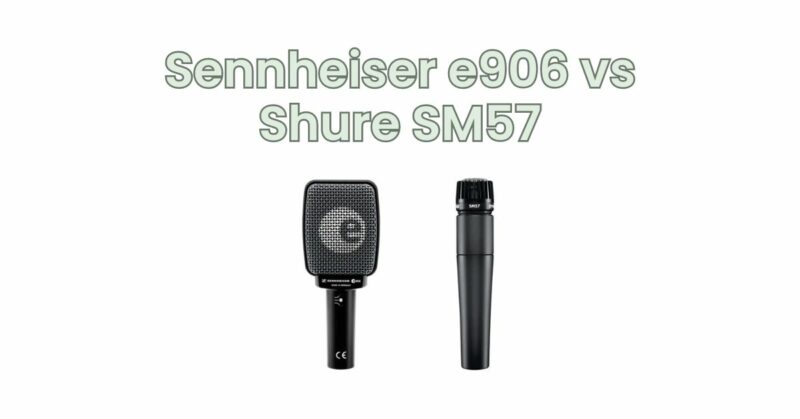When it comes to capturing the sound of musical instruments, dynamic microphones play a crucial role in delivering impactful and accurate recordings. The Sennheiser e906 and Shure SM57 are two popular choices that have become staples in studios and live performances. In this article, we will compare the Sennheiser e906 and Shure SM57, highlighting their key features, sonic characteristics, and helping you determine which microphone is best suited for your instrument recording needs.
- Sennheiser e906:
- Shure SM57:
Sennheiser e906: The Sennheiser e906 is renowned for its versatility and ability to capture the unique tonal characteristics of various instruments. Here are some key features of the Sennheiser e906:
- Sound Quality: The e906 offers a balanced and transparent sound reproduction, faithfully capturing the nuances and details of instruments. Its extended frequency response ensures accurate representation across the entire tonal spectrum, making it suitable for a wide range of instruments such as guitars, drums, brass, and woodwinds.
- Unique Design and Versatility: The e906 features a specialized design with a supercardioid polar pattern. This pattern provides excellent off-axis rejection, reducing unwanted background noise and bleed from other instruments. Additionally, the microphone’s flat shape allows for easy placement near speaker cabinets or in tight spaces.
- Integrated EQ Options: One of the standout features of the e906 is its built-in three-position presence switch. This switch allows you to tailor the microphone’s frequency response to match the characteristics of different instruments and amplifiers. It provides options for a brighter, more detailed sound or a smoother, vintage-inspired tone.
Shure SM57: The Shure SM57 is an iconic microphone that has been a staple in studios and on stages for decades. Here are some key features of the Shure SM57:
- Sound Quality: The SM57 is known for its robust and consistent sound reproduction. It offers a balanced frequency response with a slight presence boost, allowing instruments to cut through the mix with clarity and definition. Its tailored response makes it well-suited for capturing the sound of instruments such as electric guitars, drums, and brass.
- Durability and Reliability: The SM57 is built to withstand the rigors of live performances and studio use. It features a durable construction and a sturdy grille that protects the microphone from accidental impact and handling. Its reliability and longevity have made it a favorite among musicians and audio engineers worldwide.
- Instrument Versatility: The SM57 is highly versatile and suitable for a wide range of instruments. Whether you’re miking a guitar amplifier, snare drum, brass instrument, or even vocals, the SM57 consistently delivers reliable and high-quality results.
Choosing the Right Microphone: When deciding between the Sennheiser e906 and Shure SM57, consider the following factors:
- Instrument and Sound Preference: Both microphones excel at capturing instruments, but they have slightly different sonic characteristics. The e906 offers a balanced and transparent sound, while the SM57 has a slightly more pronounced midrange presence. Consider the specific instrument you’ll be recording and the desired sonic character to make the best choice.
- Placement and Off-Axis Rejection: The e906’s supercardioid polar pattern provides excellent off-axis rejection, making it a suitable choice for isolating instruments in live performances or minimizing bleed in the studio. If off-axis rejection is crucial in your recording scenario, the e906 may be the preferred option.
- Budget: Budget is an important consideration, as the e906 is generally priced higher than the SM57. Determine your budget and weigh it against the specific features and sound qualities you require.
Both the Sennheiser e906 and Shure SM57 are reliable and versatile dynamic microphones that excel at capturing the sound of instruments. The e906 offers a balanced and transparent sound with built-in EQ options, while the SM57 provides a robust and consistent sound with a classic presence boost. Consider the instrument, sound preferences, and budget to make an informed decision that aligns with your recording needs. Regardless of your choice, both microphones have proven their worth in countless recordings and performances, and they will undoubtedly serve you well in capturing the essence of your instruments.


